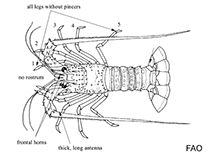Panulirus stimpsoni Holthuis, 1963
Chinese spiny lobster| Native range | All suitable habitat | Point map | Year 2050 |

|
| This map was computer-generated and has not yet been reviewed. |
| Panulirus stimpsoni AquaMaps Data sources: GBIF OBIS |
Upload your photos
Google image | No image available for this species;
drawing shows typical species in Palinuridae.
Google image | No image available for this species;
drawing shows typical species in Palinuridae.
Classification / Names Common names | Synonyms | CoL | ITIS | WoRMS
Malacostraca | Decapoda | Palinuridae
Environment: milieu / climate zone / depth range / distribution range Ecology
Benthic; depth range 0 - 40 m (Ref. 122059). Tropical; 32°N - 10°N, 99°E - 123°E (Ref. 4)
Distribution Countries | FAO areas | Ecosystems | Occurrences | Introductions
Indo-West Pacific.
Length at first maturity / Size / Weight / Age
Maturity: Lm ? range ? - ? cm Max length : 35.0 cm BL male/unsexed; (Ref. 346); common length : 28.0 cm BL male/unsexed; (Ref. 4); common length :16 cm BL (female)
Short description Morphology
A medium to large-sized crustacean. Body is greenish-brown, covered with hairs and well-developed spines. Eyes are brownish-black, with brown yellowish-white markings. Pereiopods are lined with a yellowish-white stripe which expands at the joints. Antennae long and thick, resembling a whip. Telson is flat, with a well-developed fan.
It has lengths of 16 to 28 cm (male) and 13 to 16 cm (female), total body length; 6.5 to 10.5 (male) and 5 to 6.5 (female), carapace length (Ref. 4). From shallow waters, to depths up to 40 meters. In coral reefs areas and rocky bottoms. Nocturnal and solitary (Ref. 125532).
Life cycle and mating behavior Maturity | Reproduction | Spawning | Eggs | Fecundity | Larvae
Members of the order Decapoda are mostly gonochoric. Mating behavior: Precopulatory courtship ritual is common (through olfactory and tactile cues); usually indirect sperm transfer.
Main reference
References | Coordinator | Collaborators
Holthuis, L.B. 1991. (Ref. 4)
IUCN Red List Status (Ref. 130435)
Data deficient (DD) ; Date assessed: 03 December 2009
CITES status (Ref. 108899)
Not Evaluated
CMS (Ref. 116361)
Not Evaluated
Threat to humans
Human uses
Fisheries: commercial
| FishSource |
Tools
More information
Internet sources
BHL | BOLD Systems | CISTI | DiscoverLife | FAO(Publication : search) | Fishipedia | GenBank (genome, nucleotide) | GloBI | Gomexsi | Google Books | Google Scholar | Google | PubMed | Tree of Life | Wikipedia (Go, Search) | Zoological Record



